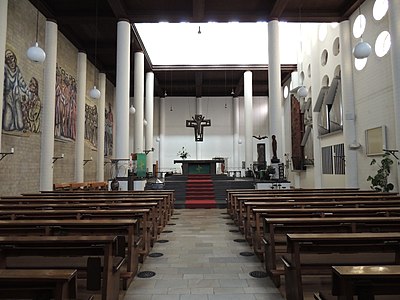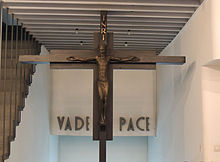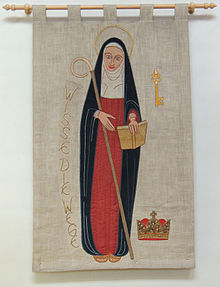Holy Spirit Church (Frankfurt am Main)
The Heilig-Geist-Kirche is a Catholic church on Schäfflestrasse in the Frankfurt district of Riederwald . It belongs to the diocese of Limburg . Since January 1, 2015, it has been part of the new type of Catholic parish St. Josef Frankfurt am Main as the church village of Heilig Geist Riederwald , to which three other churches belong as church locations and in which there are also two profile churches of the Diocese of Limburg, which are also subsidiary churches of the parish are.
history
founding
From the beginning of the second decade of the 20th century, workers' settlements were established in Frankfurt am Main in the course of increasing industrialization and rapid population growth . This also includes the Riederwald settlement built in 1910 , which was built on the former fields of the Riederhöfe of the Hospital of the Holy Spirit .
The pastoral care for Catholics in the newly formed district was initially from the Allerheilgen - parish in the district of Ostend perceived. Services were first celebrated in a barrack on Schultze-Delitzsch-Platz. From 1923, services were held in the gym of the then new Riederwald School. In the same year the building site for the church was acquired. On August 15, 1926, the foundation stone for the rectory was laid. An emergency chapel was set up there and inaugurated on April 10, 1927. The architect Martin Weber took over the planning . The client was the pastor Georg Heinrich Hörle. On April 1, 1928, the independent parish Zum Hl. Geist was founded. On July 13, 1930, the groundbreaking ceremony for the church took place. On September 1, 1930, the assembly of the steel frame began . By August 24th, the church windows were inserted into the shell , the high altar was erected and two bells raised. The Holy Spirit church was by the then Bishop of Limburg on September 20, 1931 Anthony Hilfrich consecrated .
World War II and post-war period
The church was badly damaged in the air raids on Frankfurt am Main during World War II . The last service took place on October 3, 1943. Between October 4, 1943 and March 9, 1945, the church, the rectory and the nurses' house were badly damaged by aerial bombs in multiple attacks . After the war, the church was restored. From 1942 to 1949 Wilhelm Kempf , who later became the bishop of the Limburg diocese, was the parish priest. The church tower was renovated from 1982 to 1984. From 1991 on, Peter Reulein was an A church musician at the Heilig-Geist-Kirche; since 2000 he has been cantor at the Liebfrauenkirche in downtown Frankfurt .
21st century
The parish of the Holy Spirit has maintained close relationships with the neighboring parish of the Sacred Heart of Jesus in the Frankfurt district of Fechenheim since around 2002 within the framework of a pastoral space . In 2012, the pastoral area was expanded to include the parishes of St. Josef in Bornheim and Maria Rosenkranz in Seckbach to form the pastoral area of Frankfurt-East. This existed until December 31, 2014.
On January 1, 2015, a new type of parish was created from the four parishes in the pastoral area of Frankfurt-Ost under the name of St. Josef Frankfurt am Main with the parishes of Sankt Josef Bornheim , Maria Rosenkranz Seckbach , Heilig Geist Riederwald and Herz Jesu Fechenheim . This includes the centralization of certain tasks, such as the parish secretariat. The parish now has around 16,500 members. The new logo of the entire parish of the new type consists of an X-shaped cross, which symbolizes the four individual church locations from different geographical directions. Each of the four elements stands for one of the church locations. The element for the parish of Sankt Josef Bornheim consists of a green Gothic ceiling structure, that for Maria Rosenkranz Seckbach made of purple pearls , that for Heilig Geist Riederwald yellow and red flames and that for Herz Jesu Fechenheim made of blue hearts and drops . Each church location also has its own logo, which consists of four identical elements.
Building
The church was deliberately built in a limited size and simplicity and was less monumental than the other churches of St. Boniface and Holy Cross planned by Martin Weber in Frankfurt am Main . With these Frankfurt churches, along with the Frauenfriedenskirche and the Limburg Pallottine Church, Martin Weber stands for New Building in the sense of the liturgical movement in the Roman Catholic Church . The church is directly connected to the rectory. The nave leads to Schäfflestrasse.
The groups of four round windows are characteristic. At the west ends of the portals there are reliefs made of colored glazed concrete by Arnold Hensler . On the north side is the representation of the “ 7 gifts of the Holy Spirit ” ( wisdom , understanding , advice , strength , science , piety and fear of God ), represented by seven doves on cross nimbs . Each of the seven gifts is inscribed on a so-called “Weber Cross”, which is executed in the typical Martin Weber ratio of width to height of 1: 4.
On the south side there is a representation of the “ outpouring of the Holy Spirit ”, which shows the apostles around the Blessed Mother in the form of a tree of life . The church tower rises above the choir . In the north, on the outer wall, there is a mural made of application stucco with the Annunciation to Mary as a motif. This representation by Arnold Hensler shows the proclamation of the Incarnation of Christ to Mary by the Archangel Gabriel . The floor plan is a simple rectangle measuring 16 by 36 meters. The height of the nave is about three quarters of the width. The tower is about twice as high. The steel skeleton is filled with bricks up to the base level and filled with hollow pumice stones. After the IG Farben building by Hans Poelzig the Holy Spirit Church was the second building with this type of construction in Frankfurt. The hollow pumice stones are plastered on the outside and were originally left in their natural structure and color on the inside. Later the interior walls were plastered.
The first three bells were made by the Ulrich foundry in Apolda . Removed during the Second World War, these bells were replaced by four new bells from the FW Schilling foundry from Heidelberg in 1956, which were consecrated on September 22, 1956 on the occasion of 25 years of church consecration.
| The four bells of today | |||
|---|---|---|---|
| Surname | volume | ||
| Holy Spirit | a ' | ||
| Maria | H' | ||
| Peter and Paul | d " | ||
| Pius X | e " | ||
Furnishing
The interior of the church can be reached from street level via a staircase, as in the Holy Cross Church. As there, community rooms were provided in a lower church. The church windows are tinted in different colors. The Peiner pillars are walled in a semicircle. The wooden ceiling is suspended from reinforced concrete trusses. The church tower is placed in the choir in this box-shaped room and is supported by five slim round supports. The church has a centrally arranged altar above which the church tower, which is equipped with round windows, rises as a light tower, which is open to the church interior. The light tower emphasizes the architectural and technical lighting elevation of the altar. The central arrangement of the altar anticipated ideas from the Second Vatican Council and was implemented here for the first time in a modern church in Germany. Originally, the altar was surrounded on all four sides by mobile folding seats , which was unique in Germany. In the church of St. Boniface the chancel is in its own choir and in the Holy Cross church on the front wall of the nave. The organ of the Heilig-Geist-Kirche is in the immediate vicinity of the altar island. This is separated from the church interior by a delicate grid. The altar table, the sacrament house with a depiction of the Archangel Gabriel and the covering of the altar steps are made of basalt . Above the tabernacle hanging Eternal Light lamp by Siegfried Haas in the form of a dove made of bronze , which the Holy Spirit symbolizes. By the same artist that originate cross and the altar candlesticks from 1963. To the right of the altar is located on a pillar a sculpture made of ceramic of Mary Arnold Hensler from 1927, which was previously already in the consecrated on April 10, 1927 Notkapelle. The undergrowth of the altar candlesticks symbolizes the crown of thorns . The original silver-plated bronze altar cross on Whitewood wood by Josef Hartwig is now in the entrance area near the western wall of the entrance hall. The basalt baptismal font was located in a niche near the entrance and was moved to the first step of the altar area below the anvil . On the inside of the north wall there is a cycle of frescoes by Willy Oeser depicting the work of St. Spirit in Acts . The Way of the Cross from 1951 by Ludwig Becker to particular personal meditation serve. During the Second World War, 6 of the 14 small windows of the Cross in the north wall were destroyed. The remaining 8 windows of the Way of the Cross are now part of the round windows on the west wall. Today's organ from 1959 is a pipe organ by Klais from Bonn with originally 41 sounding stops , divided into the main section, upper section, swell section and pedal . In 1979 the organ was expanded to 47 registers. Originally it was the training and examination organ of the Limburg diocese until the training and examination office moved to Hadamar .
A wall hanging depicting Hildegard von Bingen and a small organ from the St. Hildegard von Herz-Jesu branch church in Fechenheim , which was profaned in 2012 , have been in the Heilig-Geist-Kirche since then.
Transport links
The Holy Spirit Church of the light rail - lines U7 and U4 the Frankfurt U-Bahn approached above-ground subway station Schäfflestraße within a few minutes. The Frankfurt-Ost junction of the 661 federal motorway is also nearby .
Additional information
literature
- Lothar Altmann: Holy Spirit Church Frankfurt am Main . Schnell & Steiner, Munich + Zurich 1977.
- Georg Heinrich Hörle: The Holy Spirit Parish and its new church in Frankfurt am Main-Riederwald . Frankfurt am Main 1931.
- Gudrun Berger, Harald Berger, Gaby Gann, Ludwig Janzen, Heinrich Kress, Walter Kropp, Dieter Muthig, Willi Thiele, Martin Weber: 75 years of the Holy Spirit Church Frankfurt Riederwald 1931–2006 - Festschrift for the 75th consecration of the Holy Spirit Frankfurt am Main-Riederwald church . Ed .: Catholic parish of the Holy Spirit Frankfurt-Riederwald. Catholic parish of the Holy Spirit Frankfurt-Riederwald, Frankfurt am Main 2006.
- Adrian Seib: Martin Weber - The churches of the Holy Cross and Holy Spirit in Frankfurt am Main as pioneering sacred buildings in the work of the architect . In: das münster - magazine for Christian art and cultural studies . 64th year, no. 1 . Schnell & Steiner, 2011, ISSN 0027-299X , p. 3-9 .
- Franz Josef Hamm: Martin Weber and Arnold Hensler - an artist partnership . In: das münster - magazine for Christian art and cultural studies . 64th year, no. 1 . Schnell & Steiner, 2011, ISSN 0027-299X , p. 10-19 .
Web links
- Homepage of the parish of the Heilig Geist church in Frankfurt-Riederwald (accessed on February 22, 2018)
- Homepage of the parish St. Josef Frankfurt am Main (accessed on February 22, 2018)
- Bell tower on frankfurter-bilderbogen.de (accessed on February 22, 2018)
Individual evidence
- ↑ Gudrun Berger, Harald Berger, Gaby Gann, Ludwig Janzen, Heinrich Kress, Walter Kropp, Dieter Muthig, Willi Thiele, Martin Weber: 75 Years of the Holy Spirit Church Frankfurt Riederwald 1931-2006. (PDF 15.6 MB) Festschrift for the 75th parish festival of the Heilig-Geist-Kirche Frankfurt am Main-Riederwald. (No longer available online.) Catholic parish of the Holy Spirit Frankfurt-Riederwald, archived from the original on October 15, 2016 ; accessed on October 15, 2016 .
- ^ Catholic Church in the East of Frankfurt. In: homepage of the parish. Catholic Parish St. Josef Frankfurt am Main, January 2018, accessed on February 22, 2018 .
- ↑ On the way to a new parish - pastoral area Frankfurt-Ost. In: homepage of the parish. Catholic parish Zum Heiligen Geist Frankfurt-Riederwald, 2013, accessed on February 22, 2018 .
- ↑ Catholic Parish St. Josef Frankfurt am Main (Ed.): Looking through - signposts through the Catholic Parish St. Josef Frankfurt am Main . Frankfurt am Main 2015.
- ^ Catholic parish St. Josef Frankfurt am Main (ed.): The new logos . Frankfurt am Main 2015.
- ^ (Arch) bishops of Germany and Austria and the bishop of Bozen-Brixen (ed.): Gotteslob - Catholic prayer and hymn book . Edition for the Diocese of Limburg. 1st edition. Katholische Bibelanstalt GmbH / Lahn-Verlag GmbH, Stuttgart / Kevelaer 2013, ISBN 978-3-7840-0203-3 , Our diocese in history, p. 963 .
- ↑ Latin name: Liriodendron tulipifera L.
Coordinates: 50 ° 7 ′ 45 ″ N , 8 ° 44 ′ 3 ″ E






